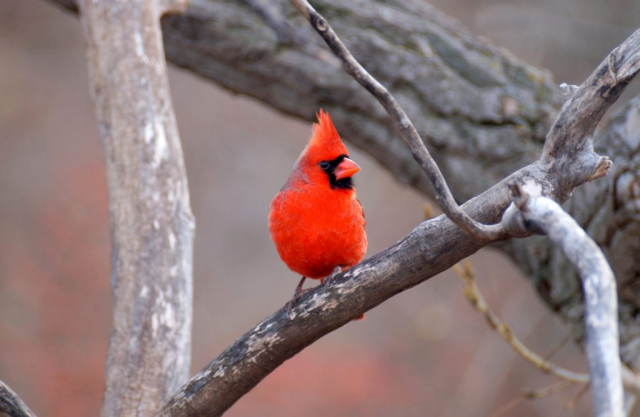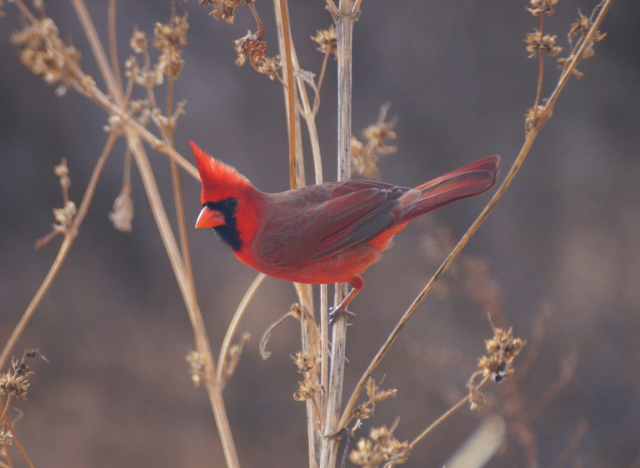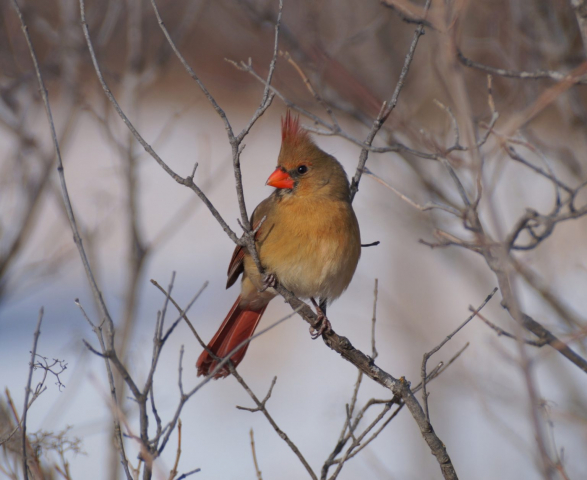Cardinalis cardinalis cardinalis
Status: Common regular resident south and east, uncommon north, locally rare west. Rare regular spring, fall, and winter visitor outside breeding range.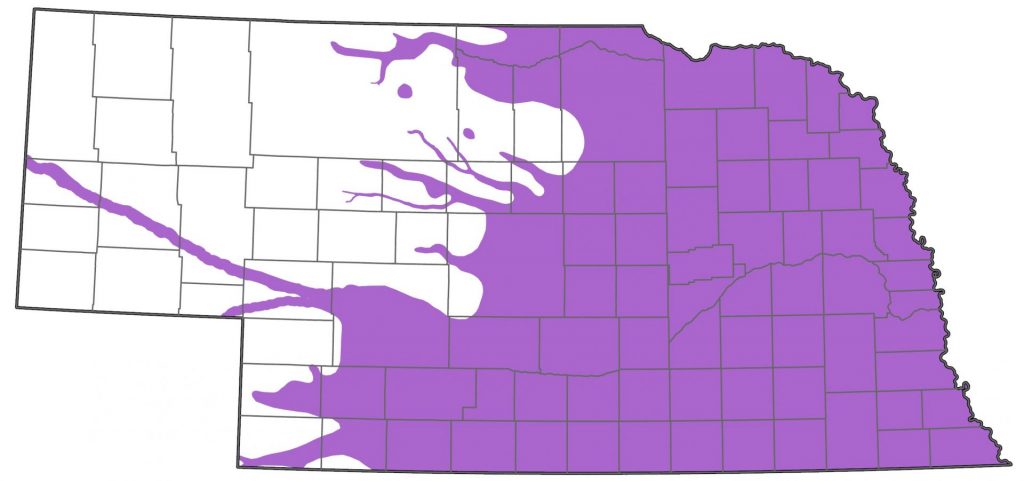 Documentation: Specimen: UNSM ZM7063, Dec 1884 Unadilla, Otoe Co. An earlier specimen, Nebraska’s first record for the species, is USNM 4854, Richardson Co 23 Apr 1856.
Documentation: Specimen: UNSM ZM7063, Dec 1884 Unadilla, Otoe Co. An earlier specimen, Nebraska’s first record for the species, is USNM 4854, Richardson Co 23 Apr 1856.
Taxonomy: Nineteen subspecies are recognized (AviList 2025); those occurring north of Mexico are superbus, resident in southern Arizona and southwest New Mexico, canicaudus, resident from western Oklahoma to southeast New Mexico and southeast Texas, magnirostris, resident in east-central Texas and southern Louisiana, floridanus, resident in the southeastern US, and cardinalis, resident from southeast North Dakota to northeast Texas and east to New Brunswick and Florida.
Nebraska birds are cardinalis.
A bilateral gynandromorph (one side male, one side female) returned to the Phil Swanson yard in Sarpy Co 10 Dec 2024 and remained through 19 Jan 2025; presumably the same bird was in the yard 15 Jan-18 Feb 2023. This is a rare form, with only six previous verified records (Poppie 2023).
Resident: Apparently Nebraska’s first record of this species as it spread from the eastern US westward (Halkin et al 2021) was a specimen collected by F.V. Hayden 23 Apr 1856 at the mouth of the Nemaha River in Richardson Co (cited above); South Dakota’s first was in 1877, also along the Missouri River. Iowa’s first record was in 1906, and Minnesota was reached in the late 1800s (Swenk 1931).
Since the early 1900s, Northern Cardinal has gradually expanded its range from the southeast (Bruner et al 1904) across the state westward, primarily along major river valleys (Short 1961), as woody vegetation developed. The range continues to expand, and individuals are regularly observed outside of the above mapped range, which represents the current established distribution of the species. BBS data analysis (Sauer et al (2020) shows Northern Cardinal has increased 2.0% annually (95% C. I. 1.39, 2.63) 1966-2019.
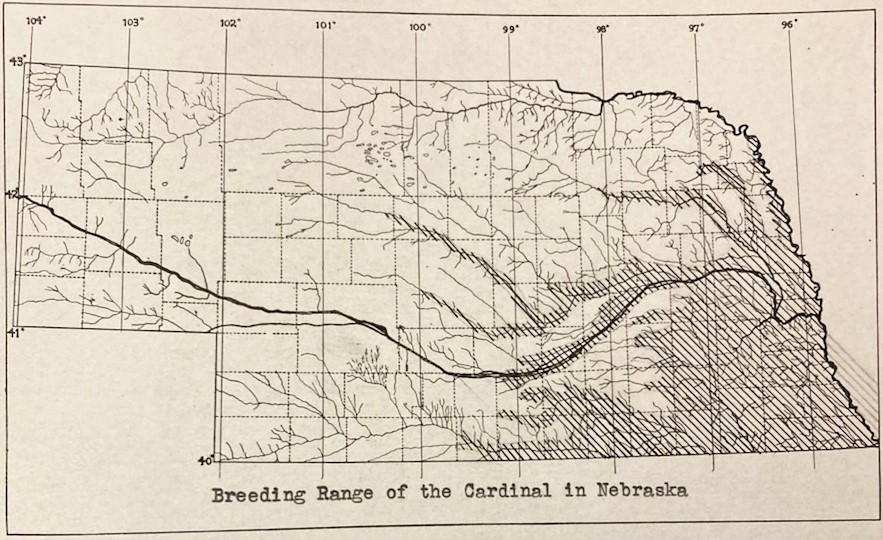
Normally a sedentary species, expansion results from immatures dispersing from the edge of the range in fall and wintering in a new location (Halkin and Linville 2021). There are winter records for most areas in Nebraska beyond the breeding range; such birds may overwinter, locate mates and nest in the following year.
As of 1958, it was breeding commonly in the eastern half of Nebraska and was uncommon to rare westward, with records as far west as the Panhandle (Rapp et al 1958). It was first reported in Lincoln Co at Sutherland 2 Nov 1933 (Tout 1947), but not until 6 Apr 1941 at North Platte, Lincoln Co and 13 Apr 1954 at Scottsbluff, Scotts Bluff Co. The first breeding record for Lincoln Co was a nest with eggs at North Platte 19 Apr 1965 (Mollhoff 2022).
The first record for the upper Elkhorn Valley was a midwinter specimen, UNSM ZM10621, collected at Neligh, Antelope Co 11 Jan 1909. Ducey (1988) cited Bruner’s (1896) statement that it bred at West Point, establishing its presence there prior to 1900. It was breeding in Wayne Co by 1953 (Gates 1953) and in Boone Co by 1984 (Bennett 1984). It is now present throughout northeast Nebraska.
In the Niobrara River Valley, this species continues to push westward. Brogie and Mossman (1983) found several singing males and territorial birds at the Niobrara Valley Preserve in 1982, listing the species as an uncommon “probable nester.” There are numerous records south of Valentine, especially at Hackberry Lake, Valentine NWR and the Merritt Reservoir area. Ducey (1988, 1989) noted an increase in numbers during the period 1984-88 at Anderson Bridge, some 20 miles west of Valentine, Cherry Co, where there have been a few reports since, including one there 5-6 Jun 2023 and several in 2025. Reports are increasing at Chat Canyon WMA, and there are these records moving westward beyond Chat Canyon WMA: 16 F crossing 15 May 2015, 7 May 2023, 12 Jun 2019, and 30 Jun 2024, Middle Boiling Springs Road crossing 21 Jul 2019, at Cody 21 Jul 2019, Eli crossing 21 Jul 2019, and 27 May 2011 Cottonwood Lake SRA, near Merriman.
The only reports farther west in the Niobrara River Valley (east and south of the Pine Ridge) are of one at Smith Lake SRA, Sheridan Co 28 Sep 2009, which is located on Pine Creek, a Niobrara River tributary, at Walgren Lake SRA, Sheridan Co 22 May 2023, arguably in the Niobrara River drainage, and at Agate Fossil Beds NM, Sioux Co 20 Sep 2017.
Most Panhandle reports are in or near the North Platte River Valley, including one at Wildcat Hills SRA 4 Jun 2019. As of summer 2023, Northern Cardinal occupies the entire North Platte River Valley. There are numerous reports from Scotts Bluff Co, where cardinals are rather widespread, albeit limited mostly to the Valley itself, although reports for the Wildcat Hills are numerous. A long-time resident of Scotts Bluff Co noted in 2020 “They continue to surprise me with the frequency of reports” (Alice Kenitz, personal communication). In 2022, Scotts Bluff Co reports were from about 10 locations. After first being recorded in Scotts Bluff Co in 1954, there were several Dec and Jan reports through 1976, followed by reports only in spring and summer through 1985. There were no additional reports until 1992, when it was listed as a “permanent resident,” although breeding was not noted until a male was seen feeding young near the North Platte River east of Scottsbluff 31 Jul 1994 (Silcock and Rosche 1994).
It is apparent from dates in the DeLara yard near Mitchell that during initial establishment there, cardinals appeared at feeders mid-winter then apparently nested nearby and brought young to the feeders the following summer and then dispersing; from 2012 to 2017 all dates were in the period 9 Dec-10 Jul (Kathy DeLara, personal communication). Increasing numbers were noted east of Scotts Bluff Co in the North Platte Valley in the 1980s; reports were from six Morrill Co locations in 1985 where previously only one location had been occupied (Williams 1985). Reports from Morrill Co were regular from 2000; it has been resident at Bridgeport SRA since. Between Bridgeport and Lewellen there are few reports, notably at Oshkosh, Garden Co: 23 Feb 2013, 12 May 2016, 13 May 2021, and two on 14 Dec, one at Lisco, Garden Co 9 Jun 2023, two on 21 Jun 2016 at Broadwater, Morrill Co, and one on 21 Sep 2013 Mud Springs, Morrill Co.
Rosche (1982) showed the species has a tenuous hold, at best, in the Pine Ridge region. Northern Cardinals were apparently seen along Bordeaux Creek, a tributary of the White River east of Chadron in Dawes Co in 1935 and 1936 (MacKinlay 1936). There were no further reports until 8 Apr 1954 and 2 May 1956 in Dawes Co, followed by reports 22 May 1957 Sheridan Co, and 2 Apr and 7 Sep 1959 and 20 May 1960 in Box Butte Co. Short (1965) had found no Northern Cardinals at his camp southwest of Merriman, Cherry Co in 1964, but found a pair and collected the male (USNM 480458) south of Rushville in Sheridan Co in summer 1964. This pair was territorial, and the male had enlarged testes. There were no more reports in the Pine Ridge region until 15 Nov 1987 in Dawes Co; since then there have been six reports at Gordon, Sheridan Co beginning 20 Feb 2017 (a pair present a few months) and one there 22 Oct 2022. The 20+ Pine Ridge reports since about 1990 suggest a gradual increase in numbers, with most reports since 2005.
Fewest reports are from the Western Sandhills, but reports are increasing slowly. Perhaps a first county record for Grant Co was one at Hyannis 14 Dec 2021; additional Grant Co singles were at Dubs Ranch 1 Feb 2023, near Hyannis 29 Jul and 10 Sep 2023, 2 May 2024, and 7 May 2025. In Arthur Co, there were two on 11 May 2016 in Arthur, three there 30 Mar 2017, two there 16-17 Sep 2017, and one on 20 May 2023. At Crescent Lake NWR, Garden Co, there were singles 27 May 1999, 8 Jun 2015, 27 May 2017, 19 Jun 2017, 17 May 2018, 25 Mar 2019, 2 Apr 2019, and 9 Jun 2024. The only recent reports for Box Butte Co, at the edge of the Western Sandhills, are at Laing Park, Alliance, beginning 19 Jun 2017, and continuing with a total of six reports through 2024, best count four there 3 Sep 2021.
Northern Cardinal has been recorded in the Loup drainage for some time. It was first reported at NNF Bessey, Thomas Co as early as the early 1940s, when 4-5 nesting pairs were present; Zimmer (1913) mentioned earlier unverified reports in winter, however, and it is now a “common permanent resident” there (Bray 1994). The first record of breeding in Thomas Co was a nest with eggs near Thedford 28 May 1965 (Mollhoff 2022). Two were at Seneca, Thomas Co 15 Jul 2023. The earliest report for the Loup drainage in Cherry Co is from Elsmere 25 May 1952. Reports at the Highway 97 Dismal River crossing in Hooker Co are two there 26 Mar 2017, 2 Jun 2019, 21 May 2020, and 6 May 2025; singles were at nearby Shimmins Lake 26 Mar 2017 and 8 MAy 2025. One was at East Cody Lake westerly on the Dismal River 13 Apr 2024. Two were at Mullen, Hooker Co 5 Jun and 31 Aug 2022, one was there 30 Jun 2023, and another 8 Aug 2024. It was at Stapleton, Logan Co, as early as spring 1933, and apparently regularly from that time until 30 Jun 1969; since then, there have been no reporters there. Beginning in 2018, reports from Tryon in McPherson Co are of singles 29 Apr 2018, 4 May 2023, 16 May 2021, 19 Aug 2019, 4 Dec 2021, and two there 9 May 2025.
Cardinals are common in Ogallala and fairly common along the South Platte River Valley, but there are only these reports south of the North Platte River Valley in the Panhandle: 1 May 2005 Sidney, Cheyenne Co, 10 Jun 1990 Cheyenne Co, 6 Aug 2013 Bushnell, Kimball Co, 11 Aug 2015 Deuel Co, 18 Aug 1919 Oliver Reservoir, Kimball Co, 6 Sep 2009 Oliver Reservoir, and 13 Oct 2013 Oliver Reservoir. Perhaps a first county record was one at Buffalo Creek WMA, Banner Co 26 Aug 2022.
The Republican River Valley has been occupied for decades; it was apparently common along Frenchman Creek in eastern Chase Co as early as 1945 (Maddux 1989), and first appeared in Webster Co in 1915. There are numerous recent reports from along the Republican River and Frenchman Creek in Dundy and Chase Cos, but only nine for Perkins Co beginning 5 Jun 2000. It has been reported regularly since 2003 at Hayes Center WMA, Hayes Co, and elsewhere in Hayes Co away from Frenchman Creek there are seven subsequent reports beginning in 2004.
- Breeding phenology:
Singing: 13-30 Jan (three records)
Nest building: 14 Mar-31 Jul
Eggs: 10 Apr- 5 Sep (Mollhoff 2022)
Nestlings: 13 Apr-14 Jul
Fledglings: 17 May-31 Oct
It was surmised that 4-5 broods were produced each year in the Verdon, Richardson Co area. An unusual clutch of six eggs, all genuine cardinal eggs, was found 12 May at LaVista, Douglas Co; Wayne Mollhoff (personal communication) noted that the largest cardinal clutch in his 71-nest database was five.
- High counts: 100 at Wilderness Park, Lancaster Co 21 May 2020, 72 at Glenn Cunningham Lake, Douglas Co, 23 Apr 2025, 67 there 31 Mar 2024, and 58 at Standing Bear Lake, Douglas Co, 7 Apr 2024.
Images
Abbreviations
NNF: Nebraska National Forest
NM: National Monument
NWR: National Wildlife Refuge
RA: Recreation Area
SRA: State Recreation Area
UNSM: University of Nebraska State Museum
USNM: United States National Museum
Literature Cited
AviList Core Team, 2025. AviList: The Global Avian Checklist, v2025. https://doi.org/10.2173/avilist.v2025.
Bennett, E.V. 1984. 1983 Nebraska nesting survey. NBR 52: 47-50.
Bray, T.E. 1994. Habitat utilization by birds in a man-made forest in the Nebraska Sandhills. M.S. thesis, University of Nebraska-Omaha.
Brogie, M.A., and M.J. Mossman. 1983. Spring and summer birds of the Niobrara Valley Preserve, Nebraska: An annotated checklist. NBR 51: 44-51.
Bruner, L. 1896. A list of Nebraska birds, together with notes on their abundance, migrations, breeding, food-habits, etc. Nebraska State Horticultural Society 27th Annual Report pp 57-163.
Bruner, L., R.H. Wolcott, and M.H. Swenk. 1904. A preliminary review of the birds of Nebraska, with synopses. Klopp and Bartlett, Omaha, Nebraska, USA.
Ducey, J.E. 1988. Nebraska birds, breeding status and distribution. Simmons-Boardman Books, Omaha, Nebraska, USA.
Ducey, J.E. 1989. Birds of the Niobrara River valley, Nebraska. Transactions of the Nebraska Academy of Sciences 27: 37-60.
Gates, D. 1953. Birds at Wayne (Nebraska). NBR 21: 4-5.
Halkin, S.L., D.P. Shustack, M.S. DeVries, J.M. Jawor, and S.U. Linville. 2021. Northern Cardinal (Cardinalis cardinalis), version 2.0. In Birds of the World (P. G. Rodewald and B. K. Keeney, Editors). Cornell Lab of Ornithology, Ithaca, NY, USA. https://doi.org/10.2173/bow.norcar.02.
MacKinlay, E. 1936. The Eastern Cardinal near Chadron, Dawes County. NBR 4: 84.
Maddux, E.H. 1989. Have the Northern Cardinal and Red-bellied Woodpecker expanded their ranges in Nebraska recently, 1968-1987? NBR 57: 87-92.
Mollhoff, W.J. 2022. Nest records of Nebraska birds. Nebraska Ornithologists’ Union Occasional Paper Number 9.
Poppie, T. 2023. (Popular Account) Cardinal Half-Male Half Female: Why It Happens + 6 Rare Sightings. Cardinal Half-Male Half Female.
Rapp, W.F. Jr., J.L.C. Rapp, H.E. Baumgarten, and R.A. Moser. 1958. Revised checklist of Nebraska birds. Occasional Papers 5, Nebraska Ornithologists’ Union, Crete, Nebraska, USA.
Rosche, R.C. 1982. Birds of northwestern Nebraska and southwestern South Dakota, an annotated checklist. Cottonwood Press, Crawford, Nebraska, USA.
Short, L.L., Jr. 1961. Notes on bird distribution in the central Plains. NBR 29: 2-22.
Short, L.L., Jr. 1965. Bird records from northern Nebraska during the breeding season. NBR 33: 2-5.
Silcock, W.R., and R.C. Rosche. 1994. Summer Field Report, June-July 1994, NBR 62: 102-116.
Swenk, M.H. 1931. The Birds of Nebraska: Part One (Family Fringillidae). Unfinished manuscript in the Nebraska Ornithologists’ Union Archives.
Tout, W. 1947. Lincoln County birds. Published by the author, North Platte, Nebraska, USA.
Williams, F. 1985. Southern Great Plains Region. American Birds 39: 931-933.
Zimmer, J.T. 1913. Birds of the Thomas County Forest Preserve. Proceedings Nebraska Ornithologists’ Union 5: 51-104.
Recommended Citation
Silcock, W.R., and J.G. Jorgensen. 2025. Northern Cardinal (Cardinalis cardinalis). In Birds of Nebraska — Online. www.BirdsofNebraska.org
Birds of Nebraska – Online
Updated 24 Jul 2025, map updated 26 Jul 2023
